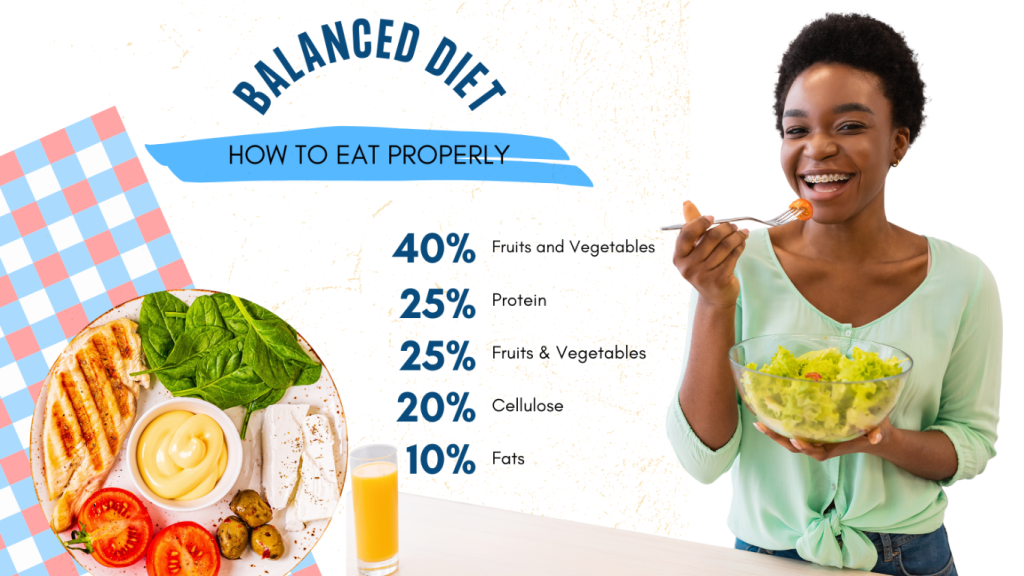Food Proportions? Your Plate, Your Power
Ever feel like you’re just guessing when it comes to healthy eating? You’re not alone. We’ve all been there, staring at our plates, wondering if we’re doing it right. But here’s the thing: eating a balanced diet doesn’t have to be complicated. It’s about understanding a few simple principles and making them work for your lifestyle.
Think of your plate as a canvas, and the food you put on it as your masterpiece. Today, we’re going to break down a super easy visual guide to help you create that masterpiece: the “40-25-25-10” rule. You might have seen the image. It’s a simple way to visualize balance diet benefits. Basically, it shows you how to divide your plate for optimal balanced nutrition.
Why does this matter? Well, a balanced diet plan isn’t just about weight loss (though it can help with that!). It’s about giving your body the fuel it needs to thrive. It’s about having energy, feeling good, and knowing you’re taking care of yourself. We want to show you what is balanced diet and how to implement it.
Understanding the 40%: Fruits and Vegetables
Now, let’s get into the nitty-gritty. That 40% dedicated to fruits and vegetables? It’s the cornerstone of your healthy eating plan. Think of it as your body’s natural vitamin and mineral boost. We’re talking about everything from crisp apples and juicy oranges to leafy greens and vibrant bell peppers. This isn’t just filler; it’s the stuff that keeps your body running smoothly.
Why are fruits and veggies so crucial? They’re packed with essential nutrients, like vitamins, minerals, and dietary fiber. Fiber, in particular, is a game-changer for your digestion and helps you feel full, which can be a lifesaver when you’re trying to manage your weight. Plus, they’re loaded with antioxidants, which protect your cells from damage.
But what if you’re not a big fan of vegetables? “How to start a balanced diet if you hate vegetables?” I hear you. The key is to start small and get creative. Try adding a handful of spinach to your smoothies, or roasting vegetables with your favorite spices. You can also try incorporating more fruit and vegetable intake into your diet by snacking on fruits throughout the day.
Remember, it’s about finding what works for you. Don’t force yourself to eat foods you hate. Instead, explore different options and discover what you enjoy. You’ll be surprised at how many delicious and nutritious fruits and vegetables are out there.

The 25% Protein Powerhouse: Building Blocks for a Stronger You
So, we’ve got our colorful foundation of fruits and veggies. Now, let’s talk about the protein part of your plate. This 25% is all about building and repairing your body’s tissues. Think of it as the construction crew for your muscles, skin, and even your hair.
Why is protein so important? It’s made up of amino acids, which are the building blocks of life. Without enough protein, your body can’t function at its best. You might feel tired, weak, or even have trouble recovering from workouts.
Now, where do you get your protein? There are tons of options, and you don’t have to break the bank. “What are the best foods for a balanced diet on a budget?” you might ask. Well, lean protein sources like chicken, fish, beans, lentils, and eggs are all great choices. You can also find protein in nuts and seeds, which make for awesome snacks.
“How to make a balanced diet for muscle gain?” is a common question. If you’re looking to build muscle, you’ll want to make sure you’re getting enough protein, especially after workouts. But remember, it’s not just about protein; it’s about balance. You need those fruits and veggies for vitamins and minerals, too.
Remember, lean protein is your friend. It’s about choosing protein sources that are low in saturated fat and high in nutrients. So, whether you’re grilling chicken, tossing lentils into a salad, or scrambling eggs, make sure protein has a place on your plate.
The Second 25%: Fruits & Vegetables (Yes, Again!)
You might be thinking, “Wait, another 25% of fruits and vegetables? Didn’t we just cover that?” Yep, we did! But here’s the thing: volume matters. This second 25% is about reinforcing the goodness, ensuring you’re getting enough of those essential nutrients.
Think of it as doubling down on your health. It’s about filling your plate with even more of those vibrant, nutrient-rich foods that make you feel good. This ensures that you are getting enough fruit and vegetable intake.
Why is this important? Because most of us don’t eat enough fruits and vegetables. By adding a second helping, you’re making it easier to meet your daily needs.
How can you do this? Add a side salad to your lunch, snack on a handful of grapes in the afternoon, or toss some extra veggies into your dinner stir-fry. Think colorful and varied.
And don’t forget, healthy snacks can play a big role in getting your fruit and veggie intake up. A sliced apple with peanut butter, a handful of cherry tomatoes, or a smoothie packed with greens are all excellent options.
By reinforcing the goodness with that second 25%, you’re ensuring your body gets the vitamins, minerals, and fiber it needs to thrive. It’s about making healthy eating a habit, not just a one-time thing.
The 20% Cellulose: Your Digestive Ally
Okay, so we’ve got our fruits, veggies, and protein sorted. Now, let’s talk about cellulose. You might be thinking, “What on earth is that?” Well, it’s basically fiber, and it’s your digestive system’s best friend.
Cellulose is a type of carbohydrate that your body can’t digest. But that’s a good thing! It adds bulk to your stool, which helps keep things moving smoothly through your digestive tract. Think of it as a natural cleaning crew for your gut.
Why is this important? Well, good digestive health is essential for overall well-being. Fiber helps prevent constipation, lowers your risk of colon cancer, and can even help regulate your blood sugar levels.
Where do you find cellulose? Fruits and vegetables are excellent sources, especially the skins. Whole grains, legumes, and nuts are also packed with fiber. So, when you’re choosing your foods, remember to opt for whole, unprocessed options whenever possible.
Think about it: whole wheat bread instead of white, brown rice instead of white rice, and leaving the skins on your apples and potatoes. These small changes can make a big difference in your dietary fiber intake.
The 10% Fats: Essential but in Moderation
Now, let’s tackle fats. A lot of people think fats are the enemy, but that’s not true! Your body needs healthy fats for energy, hormone production, and even brain function. The key is to choose the right kinds of fats and eat them in moderation.
Think of fats as the finishing touch on your balanced plate. This 10% is about adding a little bit of richness and flavor, without going overboard.
Where do you find healthy fats? Avocados, nuts, seeds, olive oil, and fatty fish like salmon are all excellent sources. These foods are packed with monounsaturated and polyunsaturated fats, which are good for your heart.
Avoid trans fats and limit your intake of saturated fats, which are found in processed foods, fried foods, and red meat.
Remember, it’s about balance. You don’t need to eliminate fats from your diet, but you do need to choose them wisely. By including healthy fats in moderation, you’re giving your body the fuel it needs to thrive. This helps with energy balance and fulfills your nutritional needs.

Putting It All Together: Practical Tips and Meal Planning
So, we’ve broken down the 40-25-25-10 rule. But how do you actually put it into practice? Let’s talk about some practical tips and meal planning strategies.
First, start by visualizing your plate. Imagine dividing it into sections: 40% for fruits and vegetables, 25% for protein, another 25% for fruits and vegetables, 20% for cellulose rich foods and 10% for healthy fats.
For example, a typical lunch might look like this: a large salad (40%), grilled chicken breast (25%), extra vegetables like bell peppers and cucumbers (25%), a side of whole grain bread (20%), and a drizzle of olive oil (10%).
“How to maintain a balanced diet while traveling?” or “easy balanced diet recipes for busy professionals.” are common concerns. If you’re on the go, pack healthy snacks like fruits, nuts, and yogurt. When dining out, choose lean protein options and ask for extra vegetables.
Meal planning can also be a game-changer. Take some time each week to plan your meals and create a grocery list. This will help you make healthier choices and avoid impulsive purchases.
Remember, it’s not about being perfect; it’s about making progress. Small changes can make a big difference over time. A balanced diet plan should always be flexible.
Addressing Specific Needs and Variations
Everyone’s different, and your dietary needs may vary depending on your lifestyle, activity level, and health goals. “How to create a balance diet for weight loss?” is a question we get a lot. To do this, focus on portion control and choose lean protein and fiber-rich foods.
“What is the importance of a balanced diet for energy?” A balanced diet provides the fuel your body needs to function at its best. Focus on complex carbohydrates, lean protein, and healthy fats for sustained energy.
“What are the balance diet tips for beginners?” Start by making small changes, like adding more fruits and vegetables to your diet. Don’t try to overhaul your entire diet overnight.
Remember, balance diet benefits extend beyond weight management. A balanced diet can improve your skin, hair, and overall well-being. What is balanced diet really about? It’s about nourishing your body and feeling your best.
Making It a Lifestyle: Sustainable Habits for Long-Term Success
Creating a balanced diet is not a short term fix. It is about making it a sustainable lifestyle.
Consistency is key. Don’t get discouraged if you have a slip-up. Just get back on track and keep moving forward.
Practice mindful eating. Pay attention to your body’s hunger and fullness cues. Avoid distractions while eating, and savor each bite.
Make small, gradual changes. Don’t try to change everything at once. Focus on one or two habits at a time, and gradually incorporate more healthy choices into your routine.
Achieving balanced diet is a journey, not a destination. It’s about finding what works for you and making it a part of your everyday life. Use eating habits and mindful eating to your advantage.
Conclusion: Your Journey to a Balanced Plate Starts Now
We’ve covered a lot of ground today. We’ve explored the 40-25-25-10 rule, discussed the importance of each food group, and shared practical tips for making it work for you.
Remember, a balanced diet is not about deprivation; it’s about abundance. It’s about filling your plate with nutritious foods that make you feel good.
Your journey to a balanced plate starts now. Take what you’ve learned and start making small changes today. You’ve got this!
Share your balanced plate creations in the comments below!



5 Responses